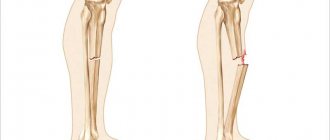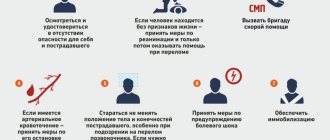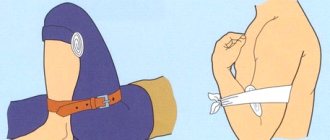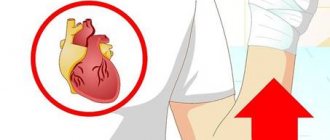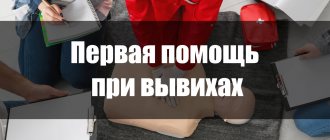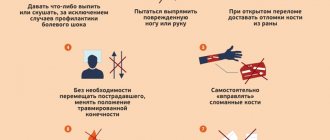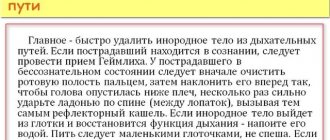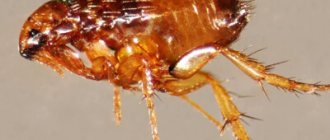Purpose and value of providing PHC
Providing first aid for various conditions and diseases has one main goal: to save the life of the injured person. People providing primary care, to the extent possible, eliminate or minimize the effect of damaging factors and evacuate people from a dangerous place as quickly as possible.
Basic instructions for providing first aid include several important points from a medical point of view:
- the optimal time for providing primary care is a maximum of half an hour (if the person is injured);
- if we are talking about poisoning, the period is significantly reduced and is 10 minutes;
- in emergency cases, when the patient stops breathing, you need to act as quickly as possible - within 5-7 minutes, no more.
The faster and more correctly PMP is provided, the fewer complications and deaths will be obtained in the end.
First aid kit
A first aid kit is a set of dressings, tools and devices designed to provide first aid. Such a first aid kit may also contain medicines. It is important that everyone has a first aid kit at home and in their car, containing a set of necessary supplies and medications, as well as medical instructions. As they say: “God protects those who are careful.”
Most of us are familiar with a car first aid kit, but it is advisable to have such a first aid kit not only in the car, but also at home. To this should be added medications for common diseases and medications for individual purposes. From time to time you need to check the expiration date of medications and store them in accordance with the instructions.
Since 2010, requirements for the composition of a first aid kit have come into force, which, according to the authors, make it possible to cope with the most common injuries, as well as to avoid the misuse of certain medications and their damage due to exposure to transportation conditions, as was the case with the drugs from the previous list. The list looks like this [Garant, 2011]:
- Hemostatic tourniquet - 1 pc.
- Non-sterile medical gauze bandage 5 m x 5 cm - 1 pc.
- Non-sterile medical gauze bandage 5 m x 10 cm - 1 pc.
- Non-sterile medical gauze bandage 7 m x 14 cm - 1 pc.
- Medical gauze bandage sterile 5 m x 7 cm 1 pc.
- Medical sterile gauze bandage 5 m x 10 cm - 2 pcs.
- Medical sterile gauze bandage 7 m x 14 cm - 2 pcs.
- Individual sterile medical dressing bag with a sealed shell - 1 pc.
- Sterile medical gauze wipes, no less than 16 x 14 cm No. 10 - 1 pack.
- Bactericidal adhesive plaster, at least 4 cm x 10 cm - 2 pcs.
- Bactericidal adhesive plaster, no less than 1.9 cm x 7.2 cm - 10 pcs.
- Rolled adhesive plaster, at least 1 cm x 250 cm - 1 pc.
- Device for artificial respiration “Mouth-Device-Mouth” - 1 pc.
- Scissors for cutting bandages according to Lister - 1 pc.
- Antiseptic wipes made of paper textile-like material, sterile alcohol, no less than 12.5 x 11.0 cm - 5 pcs.
- Non-sterile medical gloves, examination, size no less than M - 2 pairs
- Non-sterile medical mask, 3-layer, made of non-woven material with elastic bands or ties - 2 pcs.
- Isothermal rescue blanket, no less than 160 x 210 cm - 1 pc.
- Steel safety pins with a spiral, no less than 38 mm - 3 pcs.
- Recommendations with pictograms on the use of medical products, first aid kits for providing first aid to workers - 1 pc.
- Case or sanitary bag - 1 pc.
- Tear-off notepad for notes, format no less than A7 - 1 pc.
- Fountain pen - 1 pc.
This list is relevant not only for a car first aid kit, but also for first aid kits for providing first aid to workers at enterprises, according to Order No. 169n of the Russian Ministry of Health and Social Development [Garant, 2011].
Remember, you may never use a first aid kit, but you should have one.
Some sad statistics
Practical experience shows the real possibility of saving the lives of 20 out of 100 dead people, provided that first aid is provided to them in a timely manner where the accident occurred. If help is absent for an hour or more, the mortality rate increases significantly:
- 60 or more minutes - 30%;
- three hours or more - 60%;
- six hours or more - 90%.
Thus, the number of deaths approximately doubles, so you need to act quickly and correctly. First of all, measures should be aimed at eliminating a life-threatening factor, for example:
- pull the victim out of the water;
- carefully remove people from under a collapse, rubble, etc.;
- remove or remove victims from a place affected by a toxic chemical agent;
- remove a person from a car, etc.
A correct assessment of the condition in which the victim is is also equally important. It must be determined whether the person is alive or already dead. In the living, the severity of the lesion and general condition, as well as the intensity of bleeding, if any, are determined.
Types of medical care provided
Article 32. Medical assistance
- Medical care is provided by medical organizations and is classified according to the types, conditions and form of such care.
- Types of medical care include:
1) primary health care;
2) specialized, including high-tech, medical care;
3) ambulance, including specialized emergency medical care;
4) palliative medical care.
- Medical care can be provided in the following conditions:
1) outside a medical organization (at the place where the ambulance team is called, including specialized emergency medical care, as well as in a vehicle during medical evacuation);
2) on an outpatient basis (in conditions that do not provide round-the-clock medical supervision and treatment), including at home when a medical professional is called;
3) in a day hospital (in conditions that provide medical supervision and treatment during the day, but do not require round-the-clock medical supervision and treatment);
4) inpatient (in conditions that provide round-the-clock medical supervision and treatment).
- The forms of medical care are:
1) emergency - medical care provided for sudden acute diseases, conditions, exacerbation of chronic diseases that pose a threat to the patient’s life;
2) emergency - medical care provided for sudden acute diseases, conditions, exacerbation of chronic diseases without obvious signs of a threat to the patient’s life;
3) planned - medical care that is provided during preventive measures, for diseases and conditions that are not accompanied by a threat to the patient’s life, that do not require emergency and urgent medical care, and the delay of which for a certain time will not entail a deterioration in the patient’s condition, a threat to his life and health.
Article 33. Primary health care
- Primary health care is the basis of the medical care system and includes activities for the prevention, diagnosis, treatment of diseases and conditions, medical rehabilitation, monitoring the course of pregnancy, promoting a healthy lifestyle and sanitary and hygienic education of the population.
- The organization of the provision of primary health care to citizens in order to be closer to their place of residence, place of work or study is carried out according to the territorial-area principle, providing for the formation of groups of the population served at the place of residence, place of work or study in certain organizations, taking into account the provisions of Article 21 of this Federal Law.
- Primary pre-hospital health care is provided by paramedics, midwives and other medical workers with secondary medical education.
- Primary medical care is provided by general practitioners, local physicians, pediatricians, local pediatricians and general practitioners (family doctors).
- Primary specialized health care is provided by medical specialists, including medical specialists from medical organizations providing specialized, including high-tech, medical care.
- Primary health care is provided on an outpatient basis and in a day hospital.
- In order to provide citizens with primary health care in case of sudden acute diseases, conditions, exacerbation of chronic diseases that are not accompanied by a threat to the patient’s life and do not require emergency medical care, medical care units can be created within the structure of medical organizations to provide the specified assistance in an emergency form.
Article 34. Specialized, including high-tech, medical care
- Specialized medical care is provided by medical specialists and includes the prevention, diagnosis and treatment of diseases and conditions (including during pregnancy, childbirth and the postpartum period) requiring the use of special methods and complex medical technologies, as well as medical rehabilitation.
- Specialized medical care is provided in inpatient and day hospital settings.
- High-tech medical care, which is part of specialized medical care, includes the use of new complex and (or) unique treatment methods, as well as resource-intensive treatment methods with scientifically proven effectiveness, including cellular technologies, robotic technology, information technology and genetic engineering methods, developed on the basis of the achievements of medical science and related branches of science and technology.
(as amended by Federal Law dated November 25, 2013 N 317-FZ)
- No longer in force on January 1, 2015. — Part 8 of Article 101 of this Federal Law.
5 - 7. Lost force as of January 1, 2021. — Part 8.1 of Article 101 of this Federal Law (as amended on December 14, 2015).
7.1. The procedure for compiling a list of types of high-tech medical care established by the authorized federal executive body includes, among other things, deadlines after which types of high-tech medical care are included in the basic compulsory health insurance program.
(Part 7.1 introduced by Federal Law dated July 3, 2016 N 286-FZ)
7.2. The list of medical organizations that, at the expense of budgetary allocations from the constituent entities of the Russian Federation, provide high-tech medical care that is not included in the basic compulsory health insurance program is approved by the authorized executive body of the constituent entity of the Russian Federation. The procedure for forming this list is established by the highest executive body of state power of the constituent entity of the Russian Federation.
(Part 7.2 introduced by Federal Law dated December 2, 2019 N 399-FZ)
- The organization of the provision of high-tech medical care is carried out using a unified state information system in the field of healthcare in the manner established by the authorized federal executive body.
(Part 8 as amended by Federal Law dated July 29, 2017 N 242-FZ)
Article 35. Ambulance, including specialized emergency medical care
- Ambulance, including specialized emergency medical care, is provided to citizens in case of illnesses, accidents, injuries, poisoning and other conditions requiring urgent medical intervention. Ambulance, including specialized emergency medical care, is provided to citizens free of charge by medical organizations of the state and municipal healthcare systems.
- Ambulance, including specialized emergency medical care, is provided in an emergency or emergency form outside a medical organization, as well as in outpatient and inpatient settings.
- On the territory of the Russian Federation, in order to provide emergency medical care, a system of a single number for calling emergency medical care operates in the manner established by the Government of the Russian Federation.
- When providing emergency medical care, if necessary, medical evacuation is carried out, which is the transportation of citizens in order to save lives and preserve health (including persons being treated in medical organizations that do not have the ability to provide the necessary medical care for life-threatening conditions, women during pregnancy, childbirth, the postpartum period and newborns, persons affected by emergencies and natural disasters).
- Medical evacuation includes:
1) sanitary aviation evacuation carried out by aircraft;
(as amended by Federal Law dated November 25, 2013 N 317-FZ)
2) sanitary evacuation carried out by land, water and other modes of transport.
- Medical evacuation is carried out by mobile emergency medical teams, carrying out medical care measures during transportation, including the use of medical equipment.
- Medical organizations subordinate to federal executive authorities have the right to carry out medical evacuation in the manner and under the conditions established by the authorized federal executive authority. The list of specified medical organizations subordinate to federal executive authorities is approved by the authorized federal executive authority.
(as amended by Federal Laws dated November 25, 2013 N 317-FZ, dated December 1, 2014 N 418-FZ)
- Mobile emergency advisory emergency medical teams provide medical care (with the exception of high-tech medical care), including on call from a medical organization that does not have medical workers on staff of the emergency advisory emergency medical team, if it is impossible to provide the necessary services in the specified medical organization. medical care.
Article 36. Palliative medical care
(as amended by Federal Law dated March 6, 2019 N 18-FZ)
- Palliative care is a set of activities, including medical interventions, psychological measures and care, carried out in order to improve the quality of life of terminally ill citizens and aimed at relieving pain and other severe manifestations of the disease.
- Palliative medical care is divided into palliative primary medical care, including pre-hospital and medical care, and palliative specialized medical care.
- Palliative care is provided in an outpatient setting, including at home, and in day hospital and inpatient settings by medical professionals trained to provide such care. Medical organizations providing palliative medical care interact with relatives and other family members of the patient or the patient’s legal representative, persons caring for the patient, volunteers, as well as social service organizations, religious organizations, organizations specified in part 2 of the article 6 of this Federal Law, including for the purpose of providing such a patient with social services, measures of social protection (support) in accordance with the legislation of the Russian Federation, measures of psychological support and spiritual assistance.
- When providing palliative medical care, the patient is provided with medical products for use at home, designed to maintain the functions of organs and systems of the human body. The list of such medical products is approved by the authorized federal executive body.
- The regulations on the organization of palliative medical care, including the procedure for interaction between medical organizations, social service organizations and organizations specified in Part 2 of Article 6 of this Federal Law, are approved by the authorized federal executive body together with the federal executive body exercising the functions of developing and implementing state policy and legal regulation in the field of social protection of the population.
Article 36.1. Features of medical care provided within the framework of clinical testing
(introduced by Federal Law dated 03/08/2015 N 55-FZ)
- Clinical testing is the practical application of developed and previously unused methods of prevention, diagnosis, treatment and rehabilitation in the provision of medical care to confirm evidence of their effectiveness.
- Medical assistance within the framework of clinical testing is provided in the presence of the conclusions of the ethical committee and the expert council of the authorized federal executive body. The regulations on the ethical committee and expert council, their composition and the procedure for issuing relevant conclusions are approved by the authorized federal executive body.
- The Ethics Committee makes an opinion on the ethical validity of the possibility of using appropriate methods of prevention, diagnosis, treatment and rehabilitation in the provision of medical care within the framework of clinical testing and agrees on a clinical testing protocol.
- The expert council gives permission to provide medical care within the framework of clinical testing, which includes determining the number of patients who will receive medical care as part of clinical testing for each method of prevention, diagnosis, treatment and rehabilitation, and also determines the medical organizations involved in the provision of medical care. assistance within the framework of clinical testing, based on the criteria for selecting medical organizations established by the Government of the Russian Federation, provides an assessment of the financial costs of providing medical care for each clinical testing protocol and performs other functions provided for by the regulations on the expert council.
- The regulations on the organization of clinical testing and the provision of medical care within the framework of clinical testing (including the procedure for referring patients to provide such medical care), the standard form of the clinical testing protocol are approved by the authorized federal executive body.
- Medical care within the framework of clinical testing is provided in the presence of the informed voluntary consent of an adult capable patient, and in relation to a minor patient and a patient recognized as legally incompetent - in the presence of the informed voluntary consent of one of the parents or other legal representative, given in the manner established authorized federal executive body.
- Providing medical care within the framework of clinical testing is prohibited with the participation as patients of:
1) children, women during pregnancy, childbirth, women during breastfeeding, except for cases where the appropriate methods are intended for these patients, provided that all necessary measures are taken to eliminate the risk of harm to the woman during pregnancy, childbirth, women during breastfeeding, fetus or child;
2) military personnel, with the exception of military personnel undergoing military service under a contract, if the relevant methods are specially developed for use in conditions of military operations, emergency situations, prevention and treatment of diseases and injuries resulting from exposure to adverse chemical, biological, radiation factors ;
3) persons suffering from mental disorders, except for cases where the relevant methods are intended for the treatment of mental illnesses.
- The application of the requirements established by parts 2 - 5 of this article in relation to medical care provided within the framework of clinical testing using medical devices created using artificial intelligence technologies may be changed or excluded in relation to participants in the experimental legal regime in the field of digital innovation in accordance with the program experimental legal regime in the field of digital innovation, approved in accordance with Federal Law of July 31, 2021 N 258-FZ “On experimental legal regimes in the field of digital innovation in the Russian Federation.”
(Part 8 introduced by Federal Law dated July 2, 2021 N 331-FZ)
Article 36.2. Features of medical care provided using telemedicine technologies
(introduced by Federal Law dated July 29, 2017 N 242-FZ)
- Medical care using telemedicine technologies is organized and provided in the manner established by the authorized federal executive body, as well as in accordance with the procedures for providing medical care and taking into account the standards of medical care.
(as amended by Federal Law dated December 25, 2018 N 489-FZ)
- Consultations of a patient or his legal representative by a medical professional using telemedicine technologies are carried out for the purposes of:
1) prevention, collection, analysis of patient complaints and anamnesis data, assessment of the effectiveness of therapeutic and diagnostic measures, medical monitoring of the patient’s health status;
2) making a decision on the need for an in-person appointment (examination, consultation).
2.1. The requirements established by Part 2 of this article may be changed or excluded in relation to medical organizations of the private healthcare system - participants in the experimental legal regime in the field of digital innovation in accordance with the program of the experimental legal regime in the field of digital innovation, approved in accordance with Federal Law dated 31 July 2021 N 258-FZ “On experimental legal regimes in the field of digital innovation in the Russian Federation.” Financial support for the provision of medical care to citizens using telemedicine technologies within the framework of the experimental legal regime cannot be carried out at the expense of the budgets of the budgetary system of the Russian Federation, including at the expense of compulsory health insurance.
(Part 2.1 introduced by Federal Law dated July 2, 2021 N 331-FZ)
- When conducting consultations using telemedicine technologies, the attending physician can correct previously prescribed treatment, provided that he establishes a diagnosis and prescribes treatment during a face-to-face appointment (examination, consultation). The effect of these requirements may be changed or excluded in relation to medical organizations of the private healthcare system - participants in the experimental legal regime in the field of digital innovation in accordance with the program of the experimental legal regime in the field of digital innovation, approved in accordance with Federal Law of July 31, 2021 N 258- Federal Law “On experimental legal regimes in the field of digital innovation in the Russian Federation.”
(as amended by Federal Law dated July 2, 2021 N 331-FZ)
- Remote monitoring of the patient’s health status is prescribed by the attending physician after an in-person appointment (examination, consultation). Remote monitoring is carried out on the basis of patient data registered using medical devices intended for monitoring the condition of the human body, and (or) on the basis of data entered into the unified state information system in the field of healthcare, or the state information system in the field of healthcare of a constituent entity of the Russian Federation , or a medical information system, or information systems specified in Part 5 of Article 91 of this Federal Law. The effect of these requirements may be changed or excluded in relation to medical organizations of the private healthcare system - participants in the experimental legal regime in the field of digital innovation in accordance with the program of the experimental legal regime in the field of digital innovation, approved in accordance with Federal Law of July 31, 2021 N 258- Federal Law “On experimental legal regimes in the field of digital innovation in the Russian Federation.”
(as amended by Federal Law dated July 2, 2021 N 331-FZ)
- The use of telemedicine technologies in the provision of medical care is carried out in compliance with the requirements established by the legislation of the Russian Federation in the field of personal data and in compliance with medical confidentiality.
- In order to identify and authenticate participants in remote interaction when providing medical care using telemedicine technologies, a unified identification and authentication system is used. The effect of this requirement may be changed in relation to medical organizations of the private healthcare system - participants in the experimental legal regime in the field of digital innovation in accordance with the program of the experimental legal regime in the field of digital innovation, approved in accordance with Federal Law of July 31, 2020 N 258-FZ " On experimental legal regimes in the field of digital innovation in the Russian Federation.”
(as amended by Federal Law dated July 2, 2021 N 331-FZ)
- Documentation of information about the provision of medical care to a patient using telemedicine technologies, including entering information into his medical documentation, is carried out using an enhanced qualified electronic signature of a medical worker.
What are the signs of life?
The following factors are considered to be signs of life:
- a person breathes on his own. This is determined based on breath sounds and chest movement;
- the victim's pupil reacts to light stimuli. You can check the reaction of the pupil this way: quickly close your open eye with your hand, and then move it to the other side. If the person is alive, his pupil should quickly constrict.
It is also necessary to check the pulse in the area of the carotid artery.
Legal basis for the provision of primary health care
The legal basis for the provision of primary health care is established by the Federal Law of November 21, 2011 No. 323-FZ “On the fundamentals of protecting the health of citizens in the Russian Federation” (hereinafter referred to as the Law on Health Protection) and the Regulations on the organization of primary health care for the adult population, approved by order of the Ministry of Health and Social Development of Russia dated May 15, 2012 No. 543n (as amended by Order of the Ministry of Health of Russia dated June 23, 2015 No. 361n). The issues of providing primary health care to citizens entitled to receive a set of social services are regulated by order of the Ministry of Health and Social Development of the Russian Federation dated November 22, 2004 No. 255.
What should not be done when providing first aid?
Along with the rules for providing primary care for various emergency conditions, it is important to know what you should never do, so as not to worsen the already serious condition of the victims.
If a person lies in one place, he cannot be moved to another. An exception to the rule is situations that pose a direct threat to life: the spread of fire, landslides, etc. When applying a splint or bandage, be careful not to cause additional pain to the patient.
In addition, in severe conditions the following are unacceptable:
- unauthorized reposition of prolapsed organs;
- attempts to administer medications to an unconscious person;
- touching the wound cavity with hands or foreign objects;
- removal of foreign bodies from wounds if they are visible. They should be left in the same place, even if they are large and seem easy to remove at first glance. Remember that when removing any foreign object from the wound cavity, severe bleeding may occur. Before the ambulance team arrives at the scene, you need to cover the wound with dressing material and carefully bandage it.
If a person is unconscious, they should not be left lying on their back, especially if they are showing signs of vomiting. It is necessary to lay the victim on his side or turn his head if this is not possible. Shoes and clothes cannot be removed from a “severely” patient either. It is allowed to cut or tear it.
In order not to aggravate the severity of the person's psychological condition, he should not be allowed to look at the wound or damage. Those providing assistance on the spot must show restraint and composure, without betraying excitement or confusion. It is important to be able to calm a person and cheer him up.
If people are on fire, in water or under rubble, they cannot be helped without first protecting yourself.
What diseases can be treated at home?
Recently, advertising of medicines on TV and in other mass media has contributed to the formation of the belief that almost all diseases can be treated at home independently. However, this is not entirely true. Many doctors and specialists argue that self-medication can lead to an exacerbation of the disease, prevent a correct diagnosis, and cause adverse reactions [The Recovery Village, 2020].
Unlike Russia, pharmacies in the USA and some Western European countries dispense up to 90% of medications only with a prescription. This does not mean that every time you have a headache you need to go to the doctor, however, when self-medicating, you should adhere to the “do no harm” principle. Always carefully read the instructions for the purchased drug and use medications purchased on your own only to treat those diseases whose symptoms you are absolutely sure of (colds, mild sprains, rhinitis, diarrhea). Otherwise, self-medication can lead to undesirable consequences and harm your health.
According to statistics, every year around the world about 650 thousand people die from the same flu [Rosstat, 2020]. Once you feel the first symptoms of the disease, you can begin treatment at home. It has been proven that taking vitamin C, although it does not reduce the risk of getting a cold, shortens the duration of the disease and makes it easier to bear [WebMD, 2019]. Medications such as paracetamol or ibuprofen will help relieve fever. But if treatment does not produce results, and the condition worsens (the temperature rises, the cough does not go away), you should definitely seek help from a doctor.
You can also treat minor bruises, sprains, and sprains at home. They are usually fairly easy to tolerate, causing only minor pain and discomfort. If the skin at the site of dislocation or sprain does not change color, and the injury is not accompanied by swelling, it is enough to fix the site of injury and apply cold ice, providing the damaged area with rest without loading it. This recommendation should be taken with a grain of salt, and if there is a possibility of more serious injury, you should immediately seek specialized help, after following the rules described above.
Here we would like to give several important rules that should be followed when self-medicating :
| 1 | Rule 1. You can only treat easily tolerated diseases yourself. |
| 2 | Rule 2. If there is no improvement in the condition within 3 days, you need to seek qualified help at the hospital. |
| 3 | Rule 3. Before buying a drug, try to find out as much as possible about its action, contraindications, and side effects. An initial certificate can be obtained from a pharmacist at a pharmacy. |
| 4 | Rule 4. It is not recommended to resort to self-medication during pregnancy, in relation to infants and elderly people, as well as in cases of severe chronic diseases. |
There are many situations in which first aid is needed. Let's talk about the most popular of them. Please note that all the following information is taken from official sources, such as the website of the Russian Ministry of Emergency Situations, the website of the All-Russian Center for Emergency and Radiation Medicine named after A. M. Nikiforov, the website of the Firefighters and Rescuers Club, etc. and is in the public domain. If you wish, you can visit these resources and study the topic in more detail.
What simple activities should be carried out?
Of the simple measures carried out in extreme conditions, the following are effective:
- place the person in a warm place;
- use all methods to warm it up (heated bricks, hot water, blankets, available means);
- in the absence of serious damage to the abdominal wall and the person’s condition is satisfactory, he should be given plenty of fluids. The best option is plain water with the addition of a teaspoon of salt or baking soda (0.5 tsp per 1000 ml of water).
If a person’s abdominal cavity is damaged, he should not be given anything to drink. In such cases, apply a damp cloth, sponge or handkerchief to the lips.
